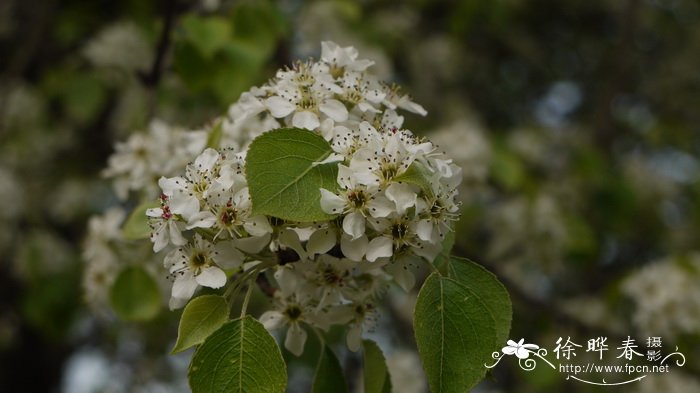杜梨Pyrus betulifolia
中文名(Chinese Name):杜梨
学名(Scientific Name):Pyrus betulifolia Bunge
英文名(English Common Name):
别名(Chinese Common Name):海棠梨、灰梨
异名(Synonym):Pyrus betulaefolia Bunge
科属(Family & Genus):蔷薇科(Rosaceae)梨属
形态特征(Description):乔木,高达10米,树冠开展,枝常具刺;小枝嫩时密被灰白色绒毛,二年生枝条具稀疏绒毛或近于无毛,紫褐色;冬芽卵形,先端渐尖,外被灰白色绒毛。叶片菱状卵形至长圆卵形,长4-8厘米,宽2.5-3.5厘米,先端渐尖,基部宽楔形,稀近圆形,边缘有粗锐锯齿,幼叶上下两面均密被灰白色绒毛,成长后脱落,老叶上面无毛而有光泽,下面微被绒毛或近于无毛;叶柄长2-3厘米,被灰白色绒毛;托叶膜质,线状披针形,长约2毫米,两面均被绒毛,早落。伞形总状花序,有花10-15朵,总花梗和花梗均被灰白色绒毛,花梗长2-2.5厘米;苞片膜质,线形,长5-8毫米,两面均微被绒毛,早落;花直径1.5-2厘米;萼筒外密被灰白色绒毛;萼片三角卵形,长约3毫米,先端急尖,全缘,内外两面均密被绒毛,花瓣宽卵形,长5-8毫米,宽3-4毫米,先端圆钝,基部具有短爪。白色;雄蕊20,花药紫色,长约花瓣之半;花柱2-3,基部微具毛。果实近球形,直径5-10毫米,2-3室,褐色,有淡色斑点,萼片脱落,基部具带绒毛果梗。花期4月,果期8-9月。
分布(Distribution):产辽宁、河北、河南、山东、山西、陕西、甘肃、湖北、江苏、安徽、江西,生海拔50-1800米平原或山坡阳处。
用途(Use):本种抗干旱,耐寒凉,通常作各种栽培梨的砧木,结果期早,寿命很长。木材致密可作各种器物。树皮含鞣质,可提制栲胶并入药。
引自中国植物志英文版:FOC Vol. 9 Page 177 |
Pyrus betulifolia Bunge, Mém. Acad. Imp. Sci. St.-Pétersbourg Divers Savans. 2: 101. 1835.
杜梨 du li Rosaceae | Pyrus
Trees to 10 m tall, often spinescent. Branchlets purplish brown when old, terete, gray tomentose when young, sparsely tomentose or glabrous when old, sparsely lenticellate; buds ovoid, abaxially gray tomentose, apex acuminate. Stipules caducous, linear-lanceolate, ca. 2 mm, membranous, both surfaces tomentose, margin initially glandular serrate, apex acuminate; petiole 2–3 cm, gray tomentose; leaf blade rhomboidal-ovate or oblong-ovate, 4–8 × 2.5–3.5 cm, abaxially sparsely tomentose or subglabrous, adaxially gray tomentose when young, glabrous and shiny when old, base broadly cuneate, rarely subrounded, margin serrate, apex acuminate. Raceme umbel-like, 10–15-flowered; peduncle gray tomentose; bracts caducous, linear, 5–8 mm, membranous, both surfaces slightly tomentose, margin entire, apex acuminate. Pedicel 2–2.5 cm, densely gray tomentose when young. Flowers 1.5–2 cm in diam. Hypanthium cupular, abaxially gray tomentose. Sepals triangular-ovate, ca. 3 mm, both surfaces tomentose, margin entire, apex acute. Petals white, broadly ovate, 5–8 × 3–4 mm, base shortly clawed, apex rounded. Stamens 20, ca. 1/2 as long as petals. Ovary 2- or 3-loculed, with 2 ovules per locule; styles 2 or 3, nearly as long as stamens, sparsely pubescent basally. Pome brown, with pale dots, subglobose, 5–10 mm in diam., 2- or 3-loculed; sepals caducous; fruiting pedicels 1–2.5 cm, gray tomentose when young, glabrescent. Fl. Apr, fr. Aug–Sep. 2n = 34*.
Open slopes, plains; sea level to 1800 m. Anhui, Gansu, Guizhou, Hebei, Henan, Hubei, Jiangsu, Jiangxi, Liaoning, Nei Mongol, Shaanxi, Shandong, Shanxi, Xizang, Zhejiang [Laos].
This species is a common tree in N China, and is often planted in gardens and parks for ornamental purposes, preferring sunny, dry, sandy, loamy soils. It is usually used as stock to graft various pear cultivars.

 (责任编辑:徐晔春)
(责任编辑:徐晔春)
学名(Scientific Name):Pyrus betulifolia Bunge
英文名(English Common Name):
别名(Chinese Common Name):海棠梨、灰梨
异名(Synonym):Pyrus betulaefolia Bunge
科属(Family & Genus):蔷薇科(Rosaceae)梨属
形态特征(Description):乔木,高达10米,树冠开展,枝常具刺;小枝嫩时密被灰白色绒毛,二年生枝条具稀疏绒毛或近于无毛,紫褐色;冬芽卵形,先端渐尖,外被灰白色绒毛。叶片菱状卵形至长圆卵形,长4-8厘米,宽2.5-3.5厘米,先端渐尖,基部宽楔形,稀近圆形,边缘有粗锐锯齿,幼叶上下两面均密被灰白色绒毛,成长后脱落,老叶上面无毛而有光泽,下面微被绒毛或近于无毛;叶柄长2-3厘米,被灰白色绒毛;托叶膜质,线状披针形,长约2毫米,两面均被绒毛,早落。伞形总状花序,有花10-15朵,总花梗和花梗均被灰白色绒毛,花梗长2-2.5厘米;苞片膜质,线形,长5-8毫米,两面均微被绒毛,早落;花直径1.5-2厘米;萼筒外密被灰白色绒毛;萼片三角卵形,长约3毫米,先端急尖,全缘,内外两面均密被绒毛,花瓣宽卵形,长5-8毫米,宽3-4毫米,先端圆钝,基部具有短爪。白色;雄蕊20,花药紫色,长约花瓣之半;花柱2-3,基部微具毛。果实近球形,直径5-10毫米,2-3室,褐色,有淡色斑点,萼片脱落,基部具带绒毛果梗。花期4月,果期8-9月。
分布(Distribution):产辽宁、河北、河南、山东、山西、陕西、甘肃、湖北、江苏、安徽、江西,生海拔50-1800米平原或山坡阳处。
用途(Use):本种抗干旱,耐寒凉,通常作各种栽培梨的砧木,结果期早,寿命很长。木材致密可作各种器物。树皮含鞣质,可提制栲胶并入药。
引自中国植物志英文版:FOC Vol. 9 Page 177 |
Pyrus betulifolia Bunge, Mém. Acad. Imp. Sci. St.-Pétersbourg Divers Savans. 2: 101. 1835.
杜梨 du li Rosaceae | Pyrus
Trees to 10 m tall, often spinescent. Branchlets purplish brown when old, terete, gray tomentose when young, sparsely tomentose or glabrous when old, sparsely lenticellate; buds ovoid, abaxially gray tomentose, apex acuminate. Stipules caducous, linear-lanceolate, ca. 2 mm, membranous, both surfaces tomentose, margin initially glandular serrate, apex acuminate; petiole 2–3 cm, gray tomentose; leaf blade rhomboidal-ovate or oblong-ovate, 4–8 × 2.5–3.5 cm, abaxially sparsely tomentose or subglabrous, adaxially gray tomentose when young, glabrous and shiny when old, base broadly cuneate, rarely subrounded, margin serrate, apex acuminate. Raceme umbel-like, 10–15-flowered; peduncle gray tomentose; bracts caducous, linear, 5–8 mm, membranous, both surfaces slightly tomentose, margin entire, apex acuminate. Pedicel 2–2.5 cm, densely gray tomentose when young. Flowers 1.5–2 cm in diam. Hypanthium cupular, abaxially gray tomentose. Sepals triangular-ovate, ca. 3 mm, both surfaces tomentose, margin entire, apex acute. Petals white, broadly ovate, 5–8 × 3–4 mm, base shortly clawed, apex rounded. Stamens 20, ca. 1/2 as long as petals. Ovary 2- or 3-loculed, with 2 ovules per locule; styles 2 or 3, nearly as long as stamens, sparsely pubescent basally. Pome brown, with pale dots, subglobose, 5–10 mm in diam., 2- or 3-loculed; sepals caducous; fruiting pedicels 1–2.5 cm, gray tomentose when young, glabrescent. Fl. Apr, fr. Aug–Sep. 2n = 34*.
Open slopes, plains; sea level to 1800 m. Anhui, Gansu, Guizhou, Hebei, Henan, Hubei, Jiangsu, Jiangxi, Liaoning, Nei Mongol, Shaanxi, Shandong, Shanxi, Xizang, Zhejiang [Laos].
This species is a common tree in N China, and is often planted in gardens and parks for ornamental purposes, preferring sunny, dry, sandy, loamy soils. It is usually used as stock to graft various pear cultivars.
踩一下[0]
下一篇:川梨Pyrus pashia

顶一下[2]